Excavations at Arsenal Tech High School
| The last
two weeks of the 2004 Archaeology Field School are being spent at Arsenal
Tech High School on Indianapolis' east side. The project this
summer will survey a series of spaces across the Arsenal campus to
determine the archaeological preservation on campus and plan possible
excavations in future seasons. The project is being sponsored by the
Indianapolis Public Schools,
IUPUI, and the Indiana
State Museum, who hopes to conduct a Project
Archaeology workshop at Arsenal. We hope that in 2004-2005 much
of the survey analysis can be conducted by Arsenal Tech students with
support from IUPUI and State Museum staff.
Right: Field school students excavating shovel test pits near the Guard House. |
Be patient: this page loads slowly
|
Before the Civil War the future Arsenal Tech High School campus was rural woods east of the city. In 1962 Arsenal High School historian Marjorie Lagemann Snodgrass painted a somewhat romanticized but nevertheless accurate picture of this area in prehistory when she described it as “virgin hardwood forest land” in which “deer munched pawpaws … bears stripped raspberries,… [and] wolves howled and foxes foraged for fresh eggs in the pheasant and quail nests.” She understood that this rather rich eco-niche was well-suited to native peoples, and she concluded that “Indians from nearby camps frequently hunted and fished in this forest.” This rich ecological harvest certainly attracted peoples in prehistory, who were followed by Europeans who first arrived in the immediate area in 1819 or 1820.
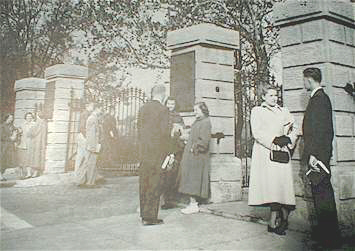 |
Left: The Michigan Street gates to Arsenal Tech as shown in the 1953 yearbook (ATHS Alumni Association). Right, the same scene from the other side of the gate during initial field excavations. | 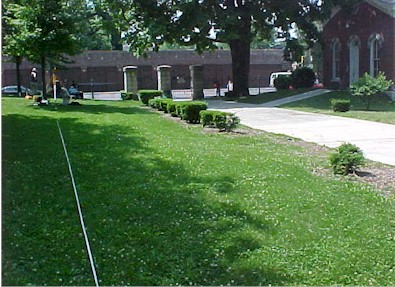 |
By 1850 the lots in the city’s original Mile Square plan had all been sold, and expansion into surrounding areas followed rapidly. By 1862 the future Arsenal tract had passed to German immigrant Herman Sturm. Sturm originally made his living manufacturing mathematical instruments, but by the outset of the Civil War he was producing cartridge samples in his home. Sturm appealed to the Governor to establish an Arsenal in Indianapolis and then went to Washington seeking Congress’ approval for the construction of an arsenal. Congress did indeed approve this, and Sturm began manufacturing cartridges on the grounds of the Indiana State House. The Indianapolis Arsenal was established by the Federal Ordnance Department in April, 1863. However, concerns over the danger of such production compelled city leaders to move the operation to a more rural setting east of the city. Sturm’s 76-acre tract was purchased for $35,000, and the federal government assumed direction of the Indiana Arsenal in 1864.
 |
Left: In 1912 Arsenal High School had just opened when this aerial view was taken, and much of this view remains remarkably similar today. Our initial excavations have tested three areas numbered 1, 3, and 7 on this map. The area within red on the left is associated with Building 1, which is the Guardhouse built in 1872. Building 2 is the Arsenal (built 1865) ; Building 3 is the West Residence (1870); Number 4 (in red outline at lower right) is Woodruff Place; Building 5 is the quadrangle office (built circa 1865, burned in 1921); Building 6 is the Barn (1869, a.k.a. Allen Hall); Building 7 is the Barracks (1869); Building 8 is the Magazine (1866); and Building 9 is the East Residence (circa 1870, demolished 1921). (From Arsenal Tech Alumni Association). |
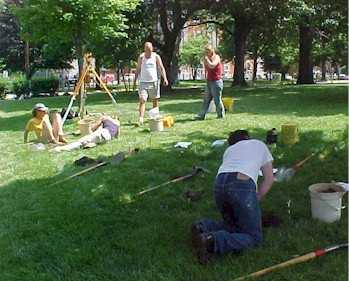 |
Left:
Shovel test pits are being placed here at five-foot intervals along the
lawn just east of the Guard house.
Right: Wade takes notes in the shadow of the gun at Arsenal's Michigan Street entrance. |
 |
| The wartime Captain of Ordinance, Thomas J. Treadwell, was succeeded by James M. Whittemore in 1864. Treadwell directed the initial grounds planning and construction of the Arsenal’s first structures, and in 1865 the Arsenal Building was the first structure completed; Whittemore subsequently directed much of the Arsenal planning and construction that followed. Nine other buildings eventually were constructed between 1863 and 1874. These included the Arsenal Building in 1865; the Magazine (1866); the Artillery Building in 1867 (modified in 1893); the Barracks in 1869; the Barn in 1869; and the West Residence in 1870. After the Civil War the Indianapolis Arsenal primarily was an arms and supply depot for the United States Army, rather than a munitions producer. The Arsenal reportedly once held 100,000 rifles. For over a quarter century the Arsenal had a complement of about 50 soldiers that observed typical military exercises found on any active military base. The Arsenal's importance declined after the Spanish-American War, and it closed in June, 1902. The grounds were purchased for $154,000 by the Winona Lake Technical and Agricultural Institution in April, 1903. The school was designed to teach skills such as painting, lithography, printing, and masonry, among other subjects, but after six years, Winona Lake went into receivership. | 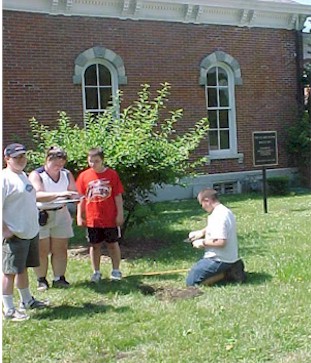 |
| Above: Scouts from Boy Scout Troop 500 assist at the Guard House. |
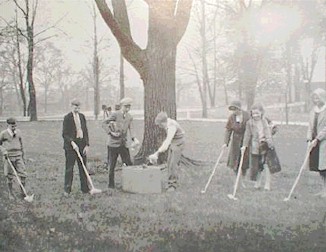 |
Left: In the 1920's these Arsenal students conducted campus cleanup--not exactly what we want to see archaeologically. Despite such projects, though, initial excavations around the guardhouse recovered a layer of refuse such as this pig bone below (photo from Arsenal Tech Alumni Association). |
|
|
 |
Right: The 1936 ATHS
yearbook included this drawing of the West Residence.
Left: The view east toward the Arsenal Building, with the West Residence on the left. |
| For more details visit the IUPUI News Center's Arsenal project press release. Please contact Paul Mullins if you have any questions about the project. For more information on Arsenal Tech's history and current academics, visit the ATHS visitors web page or the ATHS Alumni Page. For more on Project Archaeology visit the Indiana State Museum's Project Archaeology page. |
Page
last updated June 20, 2004
This page represents the author's interpretation only, not Arsenal Tech High,
its Alumni Association, the Indiana State Museum or IUPUI